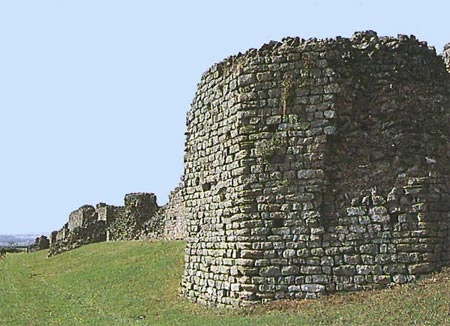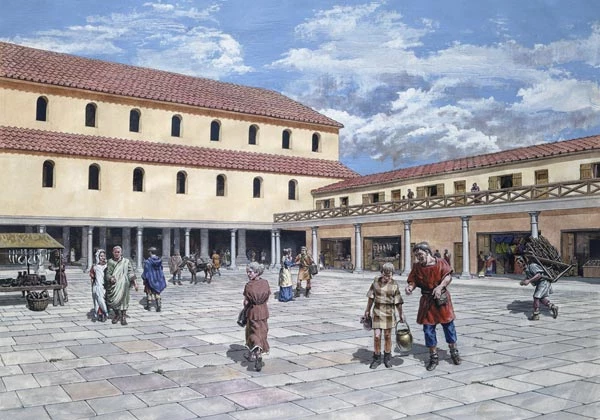The Grand Forum-basilica at Caerwent
Caerwent: the south wall and towers
The small village of Caerwent, near Chepstow in south Wales, was once the administrative capital of the Silures, the Celtic tribe occupying south-east Wales. Only two Roman towns are known to have existed in Wales: Carmarthen (Maridunum) and Caerwent (Venta Silurum).
Between 1984 and 1995 Amgueddfa Cymru - National Museum Wales undertook a programme of research excavations to improve knowledge of the early development of Caerwent. Earlier excavations had only revealed the tops of the buildings, therefore only providing a view of the late Roman town.
The Forum-basilica
Like every Roman town, at the centre was the forum (market-place) and adjoining basilica (assembly hall).Even before excavation some of the walls stood as much as 2m above ground-level, having been incorporated into 19th century farm-buildings. The forum-basilica was first explored in 1907 and 1909. Almost the whole plan of the building was recovered, but there was no firm indication as to when it was first erected. The more recent excavations uncovered parts of this impressive building for display and unravelled its structural history.
The forum, a rectangular open market-place surrounded on three sides by rooms, was entered from the main street through an archway. A paved piazza provided space for temporary stalls to be set-up on market days. The ranges of rooms, which were set behind a covered colonnade, served as shops, taverns and offices. Above these, there would probably have been a second storey, perhaps with a terrace and more rooms.
The basilica comprises a great hall and a rear range of rooms. The great hall would have been used for large public meetings and ceremonies.
Excavations of the east end of the great hall of the basilica, with the drain in the foreground
As is generally the case, the great hall consisted of a nave and two aisles divided by colonnades supporting a clerestory, like that of a great church. The walls carrying the columns had foundations almost 2m deep. The great stone columns, all carved from local sandstone, reached a height of 9m. It has been calculated that the basilica must have been over 20m high.
In the centre of the rear range of rooms was the aedes, or shrine, where statues of the Emperor and civic deities would have stood. The floor was raised above those of the rest of the basilica, giving it some prominence.
The room to the west of the aedes served as the curia or council chamber. Its south wall survives to a height of some 2m and carries painted plaster with an architectural design. In its later history, mosaic panels adorned the floor of this room. On either side of the mosaics were channels, with corresponding grooves in the plaster on the south wall. These carried the timber framework of the benches on which the councillors of the tribal assembly would have sat. Stone bases of a stepped wooden dais occupied the east end of the room from which the local magistrates would have presided over meetings of the council.
Beneath the floor of the basilica, was a box-drain which carried rainwater collected in the gutters surrounding the forum piazza. Massive blocks of local sandstone, some weighing more than a ton, were used for the sides and capping of the drain, while the base was paved in roofing tiles. A semi-circular inspection hole, cut in one of the capstones, gave access to the drain to clean it out.
Reconstruction of the forum-basilica. (Cadw, Crown Copyright)
This great building was erected in the earlier part of the 2nd century A.D. The work must have placed a severe strain on resources and finance as the forum-basilica were among the largest buildings constructed in Britain before the great cathedrals of the Middle Ages.
In the late 3rd century, the basilica appears largely to have been rebuilt. The roof of the great hall was stripped and the columns dismantled. As part of this reconstruction, the walls were strengthened and the floors were raised, probably as a result of subsidence. Structural problems may have existed from the outset, for two very large pits had been dug through the earliest floors to inspect the foundations.
Buckle and plate of a late fourth century belt found on the site of the basilica. The buckle is adorned with confronting dolphins and outward facing horses heads.
The basilica continued to function as the administrative centre until the 330s, but at that time the nature of the occupation changed. Numerous hearths were found in the nave, indicating that the great hall was being used for small-scale industrial activity. Some twenty or thirty years later the basilica was demolished, however coins struck in the 390s show continued activity on the site. The nature of this late occupation, when the rest of the town was slipping into decay and ruin, is uncertain.
The excavations at Caerwent have unravelled much of the history of this massive building, and the features described have been observed nowhere else in Britain.
Background reading
Caerwent Roman Town by R.J. Brewer. Published by Cadw (2006)



